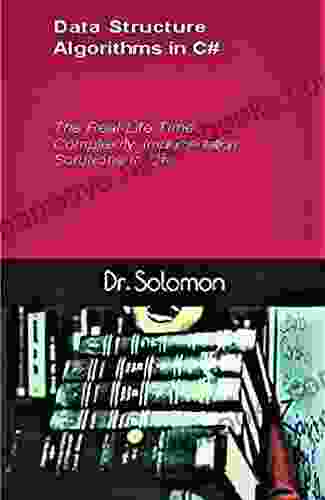Mastering the Basics of Time Complexity with Real-Life Applications

In the realm of computer science, understanding the intricacies of time complexity is paramount for optimizing algorithms and developing efficient software solutions. A comprehensive grasp of this concept empowers programmers to make informed decisions in algorithm design, performance analysis, and problem-solving.
This article delves into the fundamental principles of time complexity, providing a thorough exploration of its concepts and their practical applications in real-world scenarios. We will unravel the mysteries behind time complexity analysis, illuminating the techniques used to determine the efficiency of algorithms and guide the selection of optimal solutions.
Time complexity measures the amount of time it takes for an algorithm to complete its execution. Formally, it is expressed as the number of basic operations performed by the algorithm as a function of the input size. The input size refers to the number of elements, data points, or other parameters that influence the algorithm's execution time.
4.6 out of 5
| Language | : | English |
| File size | : | 1203 KB |
| Text-to-Speech | : | Enabled |
| Screen Reader | : | Supported |
| Enhanced typesetting | : | Enabled |
| Print length | : | 148 pages |
| Lending | : | Enabled |
Time complexity is typically represented using the Big O notation. Big O describes the upper bound on the running time of an algorithm, indicating the worst-case time complexity. For example, an algorithm with a time complexity of O(n) signifies that the running time of the algorithm will not exceed some fixed constant multiplied by n, where n represents the input size.
Algorithms can exhibit various time complexities depending on their efficiency and the nature of the problem they solve. Here are the primary types of time complexity:
- O(1) (Constant Time): Algorithms with constant time complexity execute in the same amount of time regardless of the input size. Common examples include accessing an element from an array or performing a simple mathematical operation.
- O(log n) (Logarithmic Time): Algorithms with logarithmic time complexity take a time proportional to the logarithm of the input size. This is commonly seen in search algorithms that utilize binary search or in algorithms that divide and conquer the input recursively.
- O(n) (Linear Time): Linear time complexity algorithms execute in time directly proportional to the input size. Examples include traversing an array, searching for a specific element in an unsorted list, or performing a simple loop.
- O(n log n): Algorithms with O(n log n) time complexity execute in time proportional to the product of the input size and the logarithm of the input size. This is often seen in sorting algorithms like merge sort and quicksort.
- O(n^2) (Quadratic Time): Quadratic time complexity algorithms execute in time proportional to the square of the input size. Common examples include nested loops or algorithms that perform exhaustive searches.
- O(2^n) (Exponential Time): Exponential time complexity algorithms execute in time proportional to the exponential of the input size. These algorithms are generally inefficient and should be avoided if possible.
Analyzing the time complexity of an algorithm involves identifying the number of basic operations performed by the algorithm as the input size increases. Here are the steps to follow:
- Identify the most time-consuming operation in the algorithm.
- Count the number of times the operation is executed for different input sizes.
- Express the running time as a function of the input size using the appropriate Big O notation.
Understanding time complexity is crucial in many practical scenarios, including:
- Algorithm Selection: Choosing the most efficient algorithm for a particular problem requires comparing the time complexities of different algorithms.
- Performance Optimization: Optimizing existing algorithms involves identifying and eliminating bottlenecks and inefficiencies that contribute to high time complexity.
- Resource Allocation: Estimating the resource requirements of an algorithm, such as memory or processing power, is essential for proper resource management.
- Scalability Analysis: Determining the time complexity of an algorithm helps predict its scalability and performance under increasing loads.
- Caching and Data Structures: Choosing appropriate data structures and caching techniques can significantly improve the time complexity of algorithms.
Mastering the basics of time complexity is indispensable for crafting efficient and scalable software solutions. By understanding the principles and practical applications of time complexity, programmers can optimize algorithms, analyze performance, and make informed decisions. This article serves as a comprehensive guide to this fundamental concept, empowering readers to conquer the challenges of modern software development.
For further in-depth exploration, consider investing in the book "Common Big Time Complexity Basics With Real Life Implementation Solutions." This comprehensive resource provides a wealth of knowledge and practical examples to elevate your understanding of time complexity and its applications.
4.6 out of 5
| Language | : | English |
| File size | : | 1203 KB |
| Text-to-Speech | : | Enabled |
| Screen Reader | : | Supported |
| Enhanced typesetting | : | Enabled |
| Print length | : | 148 pages |
| Lending | : | Enabled |
Do you want to contribute by writing guest posts on this blog?
Please contact us and send us a resume of previous articles that you have written.
 Book
Book Novel
Novel Page
Page Chapter
Chapter Text
Text Story
Story Genre
Genre Reader
Reader Library
Library Paperback
Paperback E-book
E-book Magazine
Magazine Newspaper
Newspaper Paragraph
Paragraph Sentence
Sentence Bookmark
Bookmark Shelf
Shelf Glossary
Glossary Bibliography
Bibliography Foreword
Foreword Preface
Preface Synopsis
Synopsis Annotation
Annotation Footnote
Footnote Manuscript
Manuscript Scroll
Scroll Codex
Codex Tome
Tome Bestseller
Bestseller Classics
Classics Library card
Library card Narrative
Narrative Biography
Biography Autobiography
Autobiography Memoir
Memoir Reference
Reference Encyclopedia
Encyclopedia Mario Leis
Mario Leis Amy Epstein Feldman
Amy Epstein Feldman Lachrystal D Ricke
Lachrystal D Ricke Alyson Richman
Alyson Richman Alison Weber
Alison Weber Anthony Haywood
Anthony Haywood Jonathan Nevair
Jonathan Nevair Alistair Smith
Alistair Smith Kathryn Petras
Kathryn Petras Alli Frank
Alli Frank Nitzan Shoshan
Nitzan Shoshan Dr Evan Mahoney
Dr Evan Mahoney Terry Crews
Terry Crews Roxanne Dunbar Ortiz
Roxanne Dunbar Ortiz Edugorilla Prep Experts
Edugorilla Prep Experts Robert S Mcelvaine
Robert S Mcelvaine Colin Fyfe
Colin Fyfe Allie Mccormack
Allie Mccormack Cheryl James Ward
Cheryl James Ward Ulrich Meyer
Ulrich Meyer
Light bulbAdvertise smarter! Our strategic ad space ensures maximum exposure. Reserve your spot today!
 Tyler NelsonFollow ·14.2k
Tyler NelsonFollow ·14.2k Edmund HayesFollow ·17.8k
Edmund HayesFollow ·17.8k Denzel HayesFollow ·15.6k
Denzel HayesFollow ·15.6k Paulo CoelhoFollow ·4k
Paulo CoelhoFollow ·4k Gordon CoxFollow ·17.2k
Gordon CoxFollow ·17.2k Dean CoxFollow ·10.1k
Dean CoxFollow ·10.1k Jamie BlairFollow ·16.7k
Jamie BlairFollow ·16.7k Ernesto SabatoFollow ·3.4k
Ernesto SabatoFollow ·3.4k

 F. Scott Fitzgerald
F. Scott FitzgeraldUnravel the Enigmatic Murder of Mary Russell: A...
Prologue: A Grisly Discovery In the...

 Connor Mitchell
Connor MitchellLittle Quilts: Gifts from Jelly Roll Scraps
Embrace the Art...

 Harold Powell
Harold PowellPoverty Survival Hope In An American City: A Pulitzer...
A testament to the resilience of the human...

 Ray Blair
Ray BlairConfronting Global Warming: Population, Resources, and...
Global warming is one of the most pressing...

 Gary Cox
Gary CoxStyle Your Most Authentic Self and Cultivate a Mindful...
Unlock Your True...

 Caleb Long
Caleb LongEmbark on a Colorful Patchwork Adventure: Discover 20 To...
Step into the captivating world of...
4.6 out of 5
| Language | : | English |
| File size | : | 1203 KB |
| Text-to-Speech | : | Enabled |
| Screen Reader | : | Supported |
| Enhanced typesetting | : | Enabled |
| Print length | : | 148 pages |
| Lending | : | Enabled |












